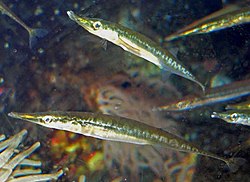
(Image courtesy of Wikipeda)
In past entries, I’ve made reference to the tubesnout(Aulorhynchus flavidus), an odd little creature that’s closely related to the sticklebacks.
Tubesnouts are currently part of the family Aulorhynchidae, sister group to the Gasterosteidae(sticklebacks). Unlike the stickleback-sygnathiform relationship, the stickleback-tubesnout relationship is supported by molecular and morphological data, so it’s unlikely to change any time soon.
At a quick glance, a tubesnout looks like a little like a pipefish, but if you look closer, you’ll see that it actually looks like a stickleback that’s been stretched out. Tubesnouts have the “iconic” stickleback features, though they’re not as obvious: instead of a few big dorsal spines, they have many very small spines, and instead of “armor”(which is actually not that common on most sticklebacks) they just have a small row of lateral line scales. Their pelvic girdle is not as robust as a threespine’s and their pelvic spines are small and lack serrations, though they do have red pelvic fin webbing like a threespine stickleback.
The mating system of the tubesnout bears some similarity to that of other sticklebacks, namely, males glue together vegetation to make small nests. Males also exhibit specific color patterns during the breeding season; the male tubesnouts that I’ve observed have a patch of black next to a patch of white on the head.
The most striking feature of the tubesnout is its elongated body and head. Many teleosts exhibit elongation (anguilliformes being the most notable), but few have elongation in both the body and the head. (though they do exist) Perhaps the most interesting thing about elongation and the tubesnouts is that there is reason to believe that elongation is ancestral in sticklebacks. Spinachia spinachia, the sea stickleback, is elongated – if phylogenetic analysis shows that it is the most basal stickleback species, it is possible that the common ancestor of the sticklebacks was elongated, and that some sticklebacks evolved a more classic fishy shape.
Leave a Reply